For notes on my Almost A-Z please click here.
A
Acar cabe rawit

In Kuningan, close to the border of West and Central Java, my counterpart Atik and I enjoyed a picnic breakfast.
At a small Chinese Indonesian catering business in Cilacap, Central Java, in the entrance to a family home replete with clothes drying racks, stacks of old cardboard boxes and an altar with an electric red candle, I tried acar cabe rawit for the first time. Pickled green bird’s eye chillies. I ate almost half the jar. “Mirip permen!” I joked. Like lollies! I have a high chilli tolerance – quite high I’d say. When I was growing up there was always a jar of sambal oelek (raw chilli paste) in the fridge to accompany Dad’s nasi goreng (still the best I’ve had) so I started early, then came years of cooking fiery Indian curries. ‘Pedas’ is spicy in Bahasa Indonesia and I use it often, mostly in conjunction with ‘banget’ – very. I love the sweet, salty tang of these piquant little chillies and do indeed sometimes eat them on their own like lollies.
Alpukat – es lilin, jus, pudding
Avocados in Indonesia are bountiful but only used for sweets; little ice creams on sticks (es lilin), pudding (puding) and smoothies (jus alpukat). I tried es lilin (‘lilin’ means candle) during week two at work when a colleague proffered a bulging plastic bag lined with newspaper. From durian, strawberry, nangka and alpukat I chose the latter. I adored the subtle sweetness and creamy chunks of ripe fruit. Jus alpukat is silky and smooth and with a swirl of chocolate sauce, wickedly indulgent. It’s sometimes mixed with coffee. I’ve only had pudding alpukat once at Bandung’s best dim sum restaurant, The Imperial, and it was divine.
Asinan sayur, asinan Bogor

Comments translation: Julia – Hi Haidar! Sorry, but you can only buy this in Bogor. It’s called asinan Bogor. It’s delicious isn’t it? I’m so sad you can’t buy it in Bandung as I crave it all the time! Haidar: Indeed, the asinan is really delicious. We don’t have anything that replicates it in Bandung. The one and only 😦
‘Asin’ means salty and ‘sayur’, vegetables. Carrot, cucumber, cabbage, bean sprouts, mustard leaves, watercress and cute little spring onion bulbs are marinated in vinegar, served with tofu and a hot, sour, watery red sauce of palm sugar, lime, chilli, garlic and terasi (shrimp paste). It’s garnished with chives and crunchy little kacang tanah (peanuts). They’re completely different to peanuts in Australia; much smaller and sweeter.
The fruit version is asinan Bogor: green mango, papaya, pineapple, kedondong, bengkuang and peppery nutmeg fruit, served with the same sauce and those tasty little peanuts. It may seem like a peculiar concoction but the multifaceted flavours and various textures make for a scrumptious crisp and soupy salad I wish I could enjoy often, but asinan sayur is only available in Jakarta and Bogor.
Ayam bakar
Simple, sweet, sticky and satisfying – chicken slathered in kecap manis and grilled.
B
Bakpau/bapau
 Bakpau/bapau are the Bahasa Indonesia names for the Chinese steamed bun, which are sold by street vendors (kaki lima), in speciality stores and in some Chinese restaurants. My favourite savoury filling contains pork so I won’t describe it here. My favourite sweet rendition is bakpau kacang merah (red adzuki beans). Quality varies greatly; good bakpau is feathery soft and spongy and amply packed with sweet, smooth filling. They’re a real treat. Poor quality pau is chewy and scant on contents, though I still have to talk myself out of buying one every time I pass a kaki lima!
Bakpau/bapau are the Bahasa Indonesia names for the Chinese steamed bun, which are sold by street vendors (kaki lima), in speciality stores and in some Chinese restaurants. My favourite savoury filling contains pork so I won’t describe it here. My favourite sweet rendition is bakpau kacang merah (red adzuki beans). Quality varies greatly; good bakpau is feathery soft and spongy and amply packed with sweet, smooth filling. They’re a real treat. Poor quality pau is chewy and scant on contents, though I still have to talk myself out of buying one every time I pass a kaki lima!
Bakpia

Bakpia ketan hitam from Kurnia Sari, Yogyakarta. Before I’d arrived in Yogya for a weekend with my oldest friend Lil, I received text messages from three colleagues informing me that if I wanted to buy bakpia, it had to be from Kurnia Sari.
Bakpia, little flaky pastry cakes which are Chinese in origin, with various sweet fillings such as mung beans, red beans or black rice, are what you bring back from Yogyakarta as oleh oleh. Oleh oleh is the Great Indonesian Tradition of buying whatever is the speciality snack of the region you’ve visited for friends, family and colleagues. Even if it was just a quick trip, you MUST bring oleh oleh. There are oleh oleh shops in every town and city, and the larger ones have special packing facilities as the quantity people purchase can be astronomical. The oleh oleh shop opposite Denpasar airport is the size of three aeroplane hangars. I know it’s not just Indonesians who return with snacks and souvenirs, but I call it The Great Indonesian Tradition because I do not believe there is another culture on the planet so obsessed with snacks. Oleh oleh is not an obligation, it’s an obsession, which I benefited from enormously in my office!

On the left is what happens when Chriswan and I have traveled a bit and haven’t seen Aisah and Vincent in a while. On the right is my little fridge after a work trip to Bogor.
Bandrek, bajigur
Bandung is surrounded by mountains and can get quite cool, especially after a downpour, so a steaming hot drink on a chilly, drizzly night is just magic. Bandrek is a traditional Sundanese beverage of ginger, cinnamon, pepper, cloves, nutmeg and chilli liberally laced with palm sugar, so a bit like chai but without the tea leaves. It’s sometimes served with slender ribbons of young coconut and leaves warm embers lingering on your tongue long after the last sip. Bandrek in Lembang, a small town at the base of a volcano crater about 20ks north which is much cooler than Bandung, is renowned as being particularly potent.
Bajigur I call ‘bandrek’s little brother’ – its ingredients are similar but it’s more sweet than spicy and is served with coconut milk and a pinch of salt.
Bolu ketan hitam
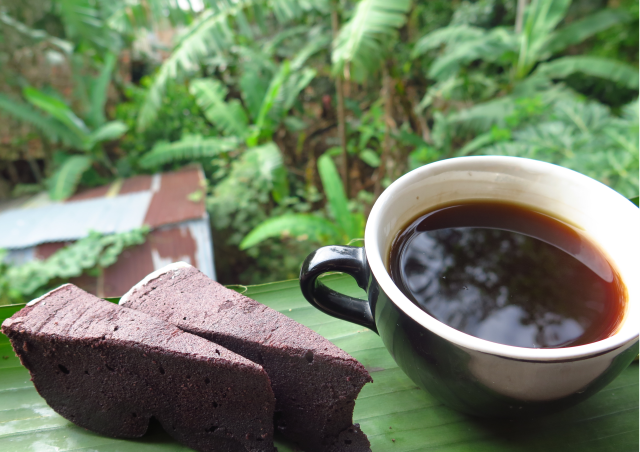
On the balcony of Aisah and Vincent’s beautiful home, Rumah Wolfard, in Bandung’s northern outskirts.
Bolu ketan hitam (steamed black rice cake) is one of the smoothest, most satisfying cakes I’ve ever tasted. With black coffee it’s sublime. Black rice has a bold, nutty flavour and blended with butter and sugar it’s decadent yet delicate, and its deep eggplant colour divine. I’ve only relished it twice; when I was first getting to know the gorgeous Aisah Wolfard at her beautiful home in Bandung’s northern outskirts not long after I’d arrived, and when (now a dear friend) I asked if she could please make it again so I could photograph it for my A-Z. Bolu ketan hitam is an Indonesian variation of a Dutch steamed cake which I have never seen on shelves nor in cake cabinets, which is a bit of a mystery to me considering Bandung’s insatiable desire for vintage sweets and snacks. Aisah’s mother taught her how to make it. It’s one of those simple yet profound pleasures – like my oldest friend’s Mum’s potato salad, my Dad’s pea and ham soup and my Mum’s roasted tomatoes – that I find blissful because they have history and are homemade.
Buah naga merah
Buah naga merah (red dragon fruit) is in my Top 5 Tropical Fruits alongside mango, mangosteen, sawo and rambutan. Whenever I’m in the fruit section I often find myself hovering over them, ogling their fuchsia skin and outrageous green curls. They’re arguably one of the most awesome looking fruit (I just Googled ‘awesome looking fruit’ and yep, plenty of buah naga merah). Muesli, fruit and yoghurt will never be this psychedelic again!
Bubur ayam
From my post Ramadan Lite: “I’d first tried bubur ayam (chicken porridge) on the front porch of Nicholas Combe’s sharehouse in Yogyakarta, Central Java, a few years ago. Silky rice porridge is sprinkled with shredded roast chicken, spring onion, crispy fried shallots, peanuts, coriander and cakwe chunks (deep-fried dough), then drizzled with kecap manis and dolloped with sambal.” I forgot the essential squeeze of lime. Bubur ayam, after nasi kuning and soto Semarang, is my favourite Indonesian breakfast. It’s hearty but not too heavy, and the combination of sharp and zingy and crisp and crunchy accompaniments with the creamy bubur is extremely satisfying.
Bubur Bali
One balmy morn Chriswan and I wolfed down a banana leaf-lined bamboo plate of bubur Bali in Ubud’s central market. It was soupier than standard bubur ayam with lashings of salty yellow chicken broth. Along with crunchy, nutty soy bean sprouts it was served with a tender, earthy little mound of kulit bawang (sautéed shallot skins). Enak sekali! Or jaen in Basa Bali.
Bubur kacang hijau, bubur ketan hitam
Kacang hijau are mung beans and ketan hitam is black glutinous rice. Gently boiled with palm sugar they slowly melt into a simple yet supremely comforting, creamy porridge that’s served with a splash of santan (coconut milk).
C
Colenak
‘Colenak’ is a combination of dicocol (to dip in sauce) and enak (delicious). No false advertising here. Fermented cassava, called peuyeum in Sundanese (I still struggle to pronounce it), is grilled and served with a thick, sinfully sweet concoction of palm sugar and shredded coconut. The texture of margarine yellow ripe peuyeum is sumptuously smooth with the fermented spike I adore. Colenak and bandrek on a chilly Bandung night make a brilliant combo, but peuyeum straight out of its little bamboo box is magic too.
D
Djahe tjang ling
Lurking in the steaming bowl of ginger syrup are cangkelang (palm fruit – see kolak), soft pink jellies and peanuts. On the surface thin round wafers float like lilypads, their crenulated edges slowly soaking up the syrup. At Sagoo/Kopi Lay, one of my favourite Bandung cafes which bristles with ethnic Chinese and Indonesian domestic and decorative relics, old fashioned confectionery and vintage batik, ‘Djahe tjang ling’ is the shortened form of ‘cangkaleng kolang kaling’ using old Dutch spelling (hence ‘djahe’ not ‘jahe’). Kolang kaling is Sundanese for cangkaleng, but Sagoo have combined the two. This warming ginger drink (the more common name is sekoteng) is another perfect beverage to sip while watching a Bandung storm and Sagoo/Kopi Lay, with its charming open courtyard, is a delightful spot to do so.
Emping (see sayur asem)
Es…
As you’ve probably guessed ‘es’ means ice. Mum recently sent me an article she’d torn out of an airline magazine about Asian desserts: “There’s nothing more refreshing than an icy Asian dessert on a scorching humid day. Studded with local fruit and assorted jellies, and topped with shaved or crushed ice, these treats come in every variation imaginable.” The variety is mind-boggling but they’re not really desserts as they’re often consumed as a snack or during a meal, not just to conclude one.
Es campur

Es campur at Warung Misbar. ‘Misbar’ is a combination of ‘gerimis bubar’, the term for an outdoor gathering of people watching films. ‘Gerimis’ means light rain or drizzle and ‘bubar’ means disperse, which is what the outdoor movie-goers did when it began to rain. This funky Sundanese restaurant constantly plays old Indonesian comedies.
‘Campur’ means mix. I reckon this is the original and the best iced brew. They’re never the same. What is that!? I’ve exclaimed on more than one occasion while gouging the crushed ice in my technicolour bowl. It could be anything from tart young mango or bright yellow nangka (jackfruit), cincau (grass jelly) cubes, avocado chunks, young coconut strips or bubur pacar (tiny pink sago pearls – I’m yet to discover the meaning of this name as ‘pacar’ means boyfriend). The colourful components bathe in coconut milk and sweetened condensed milk, sometimes with a splash of rose syrup.
Es cendol
Cendol are chewy little worms made of rice or tapioca flour dyed jade with pandan leaf extract. They squiggle around in palm sugar-sweetened coconut milk. In Bandung cendol isn’t always served with ice and is sometimes served warm – an indication of the milder climate. A mouthful of slippery, wriggly cendol with the silky golden elixir of coconut milk and palm sugar is refreshing and amusing.
Es kacang merah

Es kacang merah at Sagoo/Kopi Lay, Jalan Trunojoyo. It was more like es kacang merah surprise as along with red beans hiding under the ice was a jostle of jellies.
Just as I love the rich plumminess of bakpau kacang merah, the tender adzuki beans in this simple icy dish with coconut milk and a light drizzle of sweetened condensed milk are delectable.
Es kelapa muda
Kaki lima selling es kelapa muda (iced young coconut water) are ubiquitous throughout Indonesia. The first one I had was in Jakarta at a warung opposite the hotel where we were staying for our in-country orientation. I was with three volunteers, two of whom lived in Ubud in Bali so were well acquainted with es kelapa muda’s hydrating super powers. Four giant coconuts on orange plastic plates were placed carefully on the table, each containing about a litre and half of cool coconut water and luscious white flesh. Sarah must’ve seen my eyes bulge at my coconut’s capaciousness. “Don’t worry. Everything can be dibungkus – wrapped up and taken away!” Love this country, I thought. Despite our hearty attempts about half our coconut’s contents remained, so it was expertly extracted in seconds with a special scraping instrument and poured into four little plastic bags for later.
On a merciless, muggy morning in Jakarta after we’d had one too many Bintangs the night before, fellow AVID Rachael and I bought a couple of es kelapa muda dibungkus while waiting for a cab. They just about saved our lives.
Es kopyor

Es krim kopyor at Sumber Hidangan, Jalan Braga – an ancient bakery that’s barely changed in 85 years.
Kopyor is a curious beast – a mutant coconut. While the flesh and water of normal coconuts are separate, due to spontaneous mutation kopyor’s contents is curdled, but not custardy like you might expect. The texture is quite peculiar; slightly grainy, claggy, congealed, but very tasty. It’s much sweeter too and highly prized; according to Pak Wiki its oil can fetch up to four to five times the price of regular coconut oil. It’s one of my favourite ice cream flavours and es krim kopyor at charming old Sumber Hidangan is a quintessential Bandung experience.
Es mangga muda
Ice, young mango and a smidge of sugar syrup; this pretty drink is perfect for spicy Sundanese lunches.
G
Gingerbons
 During our in-country orientation we had 20 hours of Bahasa. Our guru, Ibu Fifi, the wackiest woman I’ve ever encountered dispensed Gingerbons during the first class. From that moment I was hooked. I LOVE ginger. Gingerbons have just three ingredients: tapioca flour, sugar and ginger. Lots of ginger. They’re warm and spicy and if I’m not careful half a bag can disappear in one hit.
During our in-country orientation we had 20 hours of Bahasa. Our guru, Ibu Fifi, the wackiest woman I’ve ever encountered dispensed Gingerbons during the first class. From that moment I was hooked. I LOVE ginger. Gingerbons have just three ingredients: tapioca flour, sugar and ginger. Lots of ginger. They’re warm and spicy and if I’m not careful half a bag can disappear in one hit.
I
Ikan mas (see pepes)
J
Jengkol

Jengkol manis and jengkol pedas at Nasi Bancakan (my favourite old-school Sundanese dining hall), Jalan Trunojoyo.
Jengkol, like pete, is another food that Indonesians are often amazed to learn I like. It’s a large round legume native to Southeast Asia with an extremely intense smell and deep flavour that hangs in your mouth for hours unless it’s doused with black coffee (or one chews a few Gingerbons). It’s often curried in a sauce similar to rendang or fried with chillies and spring onions. I asked my counterpart Atik how she would describe jengkol: “Apa ya… it’s unique. Just unique.” My colleagues go crazy for it. When there’s a jengkol fry up in the kitchenette its aroma is inescapable and when it lands on the table it’s gone in seconds.
K
Kangkung
In Chinese restaurants in Australia you may have had Chinese water spinach (also known as morning glory – the one at Happy’s in Canberra was the king, wouldn’t you agree Nelly? To hell with MSG hangovers!) or anywhere throughout Southeast Asia as it’s prolific. Kangkung is the Indonesian name, and when the hollow stems are stir-fried with a good amount of diced garlic, ginger, chilli and a touch of terasi, it’s my favourite light dinner. When I feel I need a little more nourishment I’ll hot-foot it down to Warung Cahaya Laut where it’s served piping hot with baby mussels, squid and prawns. There are many variations; below are two more of my faves.
Cah kangkung
Almost all kangkung dishes are cah kangkung as ‘cah’ means stir-fried, but in some Chinese Indonesian restaurants it’s served far more elaborately. For this version, dark green stems and leaves, succulent slivers of beef and cute little quail eggs wallow in a wide, steaming hotplate of viscous, peppery sauce. It’s a perfect balance of sweet, sour and spicy, and trying to pick up the slippery little eggs with your chopsticks is a lot of fun too.
Plecing kangkung
I’ve only had this twice but not in Lombok where it originates and I’m sure is far more flavourful, but in a Lombok restaurant in Bandung. A tangle of kangkung is blanched and served with a thick sauce of diced tomato (an ingredient uncommon in Sundanese cuisine apart from sambal and some salads) seasoned with Cayenne pepper, nutmeg, terasi and lime, a little mound of finely diced coconut and garlic, and scattered with bean sprouts and peanuts. Atik informed me in Lombok they use a different kind of terasi and kangkung. “So this is like plecing kangkung Sunda?” I asked. “Exactly.”
Karedok
I can’t recall who first told me the saying “If you leave a Sundanese person in a garden they’ll be happy”, but I’ve heard it many times since. Sundanese cuisine is renowned for its freshness and vast array of veggies and herbs, served raw or as steamed salads. There’s always a big basket of lalap, chunks of cucumber, cabbage, choko and kemangi (lemon basil) at Sundanese restaurants, which operate as a buffet. If a vegetarian or vegan were to reside in Indonesia I would wholeheartedly recommend West Java.
From my post The Week of One Thousand Photos: [Karedok] is my favourite Sundanese salad. A hearty paste of powdered peanuts, ginger, galangal, garlic, terasi (shrimp paste), palm sugar, a pinch of salt, bird’s eye chillies and a smidge of water is mashed together with a pestle in a wide, shallow mortar. Then in go raw crunchy snake beans, bean sprouts, cabbage, cucumber, baby eggplant and lemon basil leaves. All but the latter is sliced aerially which always impresses the hell out of me. Served with a sprinkling of fried shallots it’s a delicious staple in my diet of which I never tire.
Kerupuk tenggiri
‘Kerupuk’ are crackers and in Java they’re eaten with almost everything. Garden variety prawn crackers are consumed but they’re just one of hundreds of flavours that come in an infinite assortment of shapes and sizes. I often joke I’m on a ‘no kerupuk diet’ lest my plate of karedok is covered with them. Hardly a day goes by when I don’t smile wide at a tukang kerupuk almost entirely obscured by elephantine bags of DDN (the most popular brand) attached to his scooter. I’ve even witnessed serious anxiety when the unforgivable crime of forgetting to buy kerupuk for an office lunch is committed. My colleagues freak out.
I do attempt to avoid them, but there is one type I’ll happily gobble guilt free as they’re just too damn delicious and they bring back happy memories. Kerupuk tenggiri are fish crackers made from Spanish mackerel. The fish is mixed with rice flour and steamed in banana leaves, then sliced, sun dried then fried. They’re prime oleh oleh from the Central Javanese cities of Jepara and Cilacap. Chriswan, his sister Shierly and I popped a helluva lot of the light and crunchy capsule-shaped kerupuk while in Cilacap for the Lebaran holiday. Half a bag could disappear in seconds. They’re perfect movie watching snacks, and are tastiest dipped in sambal terasi (or in my case, smothered in it).
Klepon
Before I moved to Indonesia I spent two months at home in Alice and was extremely fortunate to receive ten free hours of Bahasa Indonesia lessons at the Alice Springs Language Centre, which is based at my old high school. My teacher was a softly-spoken, slow-moving bespectacled man called Pak Peter, from Ambon, East Indonesia. I swear it would take him half a minute to swivel 45 degrees in his chair to face me or to remove his glasses and place them on his desk gently, but I delighted in these protracted, precise movements. To thank Pak Peter and the Centre’s Principal Dominique Castle (my Bahasa Indonesia teacher in Grade 6 – if only I’d continued with it in high school!), I wanted to make them some traditional Indonesian sweets, so that’s exactly what I Googled. Klepon seemed like a winner due to its multiple search results and they looked pretty cute and easy to make too.
Glutinous rice flour is mixed with water until it becomes marvelously malleable dough, and pandan essence is added for colour and flavour. I am tremendously grateful for the sole Asian grocery store in Alice Springs! The dough is then formed into little balls, palm sugar is spooned in and the dough sealed around it. I was using small blocks of palm sugar that required grating, and with this frictional heat the sugar melted slightly so it too was malleable. I then had the idea of rolling a collection of sugar marbles to insert into the bigger ones, which worked wonderfully. The balls are then dropped into gently boiling water and when they float to the top (just like gnocchi) they’re fished out and rolled in shredded coconut. The joy of klepon is when you pop one in your gob (and it is crucial you do so in one go – believe me, I learnt the hard way) the sugar, liquefied by the boiling water, squirts into your mouth.
After the multiple results from my ‘traditional Indonesian sweets’ search I thought klepon would be something every Indonesian would know. Perhaps they’d even be a childhood favourite of Pak Peter’s. But this was just another reminder to never make assumptions about Indonesia. Dom Castle knew klepon, as did the Vice Principal, an Australian woman, but to my dismay Pak Peter didn’t know them at all! There are no klepon in Ambon. He seemed to enjoy them nonetheless, and as the ball burst in his mouth I rejoiced in his prolonged expression of surprise.
I used this recipe.
Kolak

Kolak whipped up for buka puasa by Aisah Wolfard with a little help from yours truly (tasting duties mostly), and kolak sellers in Cilacap during Ramadan.
Kolak is a sweet drink of palm sugar and water boiled with pandan leaf then ladled with coconut milk if one prefers it creamy. The most popular varieties are kolak pisang (containing thick, soft banana slices), kolak biji (little sweet potato and tapioca flour dumplings), and kolak campur, a mixture of both along with the peculiarly textured (you’d swear they were firm jelly), almost transparent and fantastically-named palm fruit kolang kaling (which is Sundanese for cangkelang).
I have a special relationship with kolak. As I described in my post Ramadan Lite, out of solidarity with my colleagues I fasted for Ramadan this year (it was ‘Ramadan Lite’ as I still drank water). Kolak is one of the most popular foods with which to buka puasa (break the fast), and boy oh boy was it my fav! That first six o’ clock sip of silky sweetness and thick soft slice of banana after not eating since dawn was divine! I loved it so much I’m genuinely thankful it’s only abundant for one month of the year.
Kripik pisang
So we’re not talking your regular boring, healthy banana chips here. We’re talking thick slices of pisang nangka (a giant banana variety), coated in palm sugar and lemon, or palm sugar and coffee, and fried ‘til they’re golden, sticky, crunchy and dangerously irresistible.
Kue bugis
Kue bugis, steamed tapioca or sticky rice flour cakes, come in a kaleidoscope of colours. The three in this photo are green from pandan essence (bugis ketan Mataula), purple from sweet potato (bugis ubi ungu) and white from coconut milk (bugis Bogor), but they all contain the classic combo of sweetened shredded coconut. The green kue bugis is wrapped in its banana leaf with a salted coconut cream sauce which balances the sweetness exquisitely.
Kue bulan
Until Bandung supermarkets and malls were garlanded in paraphernalia from mid-August I wasn’t aware of the Chinese Mid-Autumn Festival and the indispensable little cakes consumed during it. Towering banners promoting the pastries sprang up and tables were piled high with small plastic containers and ornate gold boxes. The Moon Festival was declared in honour of the Moon Goddess of Immortality under the Song Dynasty (960 – 1279), and is actually just one day, the 15th of the eighth lunar month. (This is of course a mooncake-sized history; there are many more wondrous features well worth a Wiki – even a folk tale about the overthrow of Mongol rule facilitated by messages hidden in elaborate mooncake designs.)
Come September kue bulan, mooncakes, were everywhere and they looked marvellous, so naturally I got into the festive spirit and took some kacang hitam (black bean) cakes home with me. I made a cup of green tea and it was, dear readers, love at first bite; the thin pastry was soft and tender and the rich, dense filling not too sweet. One day I hope to be in China for the Mid-Autumn Festival, but in the meantime I’m over the moon that this brand of kue bulan kacang hitam seem to be available year-round as they’re still on the shelves!
L
Lotek
This Sundanese salad is generally always available alongside karedok as they’re dressed with the same saus bumbu bumbu (sate sauce) and made with the same method, but unlike karedok its ingredients, green beans, cabbage, bean sprouts and lemon basil, are steamed, not raw. After discovering lotek I knew I’d probably never go back to gado gado as lotek is similar but not as stodgy.
M
Martabak

Click on the image for a YouTube video of a Maverick Martabak Man in North Jakarta. Video by Chriswan Sungkono.
Martabak. Doesn’t it just sound like something loaded with carbs, slathered with calories and smeared with grease? ‘Mutabbaq’ means ‘folded’ in Arabic and it’s essentially a pancake stuffed and smothered with various fillings which is found in Saudi Arabia, Yemen, India, Malaysia, Singapore, Brunei, Thailand and across Indonesia. Half the fun of indulging in a dripping slice of martabak is the show, which is really only a feature of the sweet version. The martabak men wield their knives like samurai, drizzling and slathering and smearing and slicing with jaw-dropping speed and precision. Sweet corn kernels, sweetened condensed milk, peanuts, chocolate sprinkles, cheese; the mere sight of their swift and meticulous knife work as they construct these calorific creations is enough to clog your arteries!
The first time I succumbed to martabak’s evil allure I stood transfixed, eyes bulging at the amount of Nutella spread on the giant spongy golden pancake (one jar for one martabak), and then when it was folded I was stunned by the extra splodge of butter. The martabak man held the lid of a pan vertically to obscure my view. “Jangan lihat!” he warned. Don’t look! Urban legends abound about people dropping dead from heart attack midway through a hunk of martabak. At least three friends impervious to astronomical calorie counts are a must.
N
Nagasari
Before moving to Indonesia I discovered an article on Jakarta Post’s travel site about Bandung’s traditional cake market where an “overwhelming variety” of sweet, sticky treats go for as little as seven cents apiece. “Seven cents!” I crowed to my friends. “God I hope it’s not on the way to work – I’ll be ruined!” It turned out the cake market on Jalan Buah Batu is a safe six ks from my street, Jalan Tirtayasa. On Jalan Tirtayasa, however, is Sari-Sari, which has ‘Aneka Kue Jajan Pasar’ emblazoned on its elegant green sign. Assorted Cakes and Snack Market. Its variety, though contained in a mid-sized café, is still overwhelming.
Sari-Sari has a delightful history. It was once simply a small store stocked by a handful of suppliers that grew into bigger one, which became extremely popular with Bandung’s elite. Buying traditional cakes and snacks at Sari-Sari was the hip thing to do. It also stocked chocolates, lollies and imported goods. Then in the early 2000s modern cakes like brownies and pisang bolen became the craze and large stores such as Prima Rasa, Kartika Sari and Amanda (the latter two are now hugely successful franchises) stole most of Sari-Sari’s clientele, and it eventually closed. But we all know how vintage came into vogue. Demand for traditional cakes reignited and so did Sari-Sari, rising like a sticky, sweet phoenix from the sugary flames to land about 200m from my place and on my route to work.
Of all the dizzying array of traditional Indonesian sweets nagasari is my fav. The rice flour (not glutinous this time) and coconut milk cake, which is wrapped in a banana leaf and steamed, is delicate with just a touch of sweetness and the big chunk of banana within is always rich and ripe. But I think the main reason I love nagasari is its name; ‘naga’ is dragon and ‘sari’ is essence, though I’m yet to discover how a little rice flour cake would have anything to do with essence of dragon.
Nasi campur
Although nasi campur (rice with various accompaniments) is eaten throughout the archipelago, in my experience it’s only called nasi campur in Bali. In Java it’s nasi rames. As I wrote in Manta Eclipse, I thoroughly relished ploughing through a brown paper parcel of nasi campur on the boat between dives, and particularly loved the serundeng (spiced shredded coconut).
Nasi kuning
Nasi kuning is my favourite Indonesian breakfast. It’s fragrant, slightly sweet, coloured and flavoured with turmeric and cooked with lemongrass and coconut milk. Like nasi campur/rames it’s accompanied by a scrumptious variety of vegetable and meat dishes depending on the region; in West Java urap (later on down the list), sambal goreng (tempeh rectangles in a spicy caramel sauce) and abon sapi (beef floss) are pretty popular. My favourite in Bandung however is only served in the evening on the city’s best and most bustling nocturnal street food nirvana, Jalan Cibadak (which should be, in my mind, renamed Jalan Enak). Each time I delighted in announcing to the rotund old tukang, “Masih yang paling enak di Bandung Pak!” It’s still the most delicious in Bandung.
Nasi lengko
A speciality of Cirebon, which is on the border of West and Central Java (a mix of Sundanese and Javanese is spoken), nasi lengko is great for a tasty light vegetarian lunch. Bean sprouts, diced cucumber, then cubes of tempeh and egg are layered on a bed of white rice and sprinkled with a good handful of chives. There’s a pool of sate sauce on the side and underneath the rice a splash of soy sauce seeping through. I have rarely encountered soy sauce in Indonesian cuisine – megalitres of kecap manis of course – but soy sauce is scant so its inclusion is intriguing.
Nopia
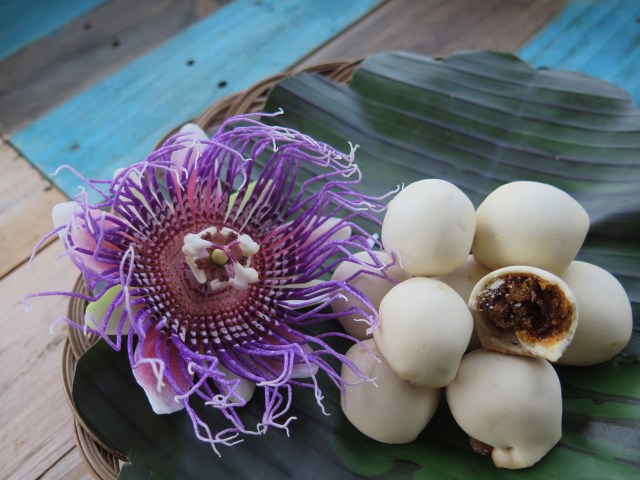
Nopia mini rasa brambang. I accidentally knocked the passionfruit flower off its vine so thought I should at least put it to good use!
Nopia are goose egg-shaped wheat flour cakes baked in a clay furnace fueled by the wood of coconut palms, which are manufactured in Banyumas, a regency in southwest Central Java. Lining their hollow interior is a rich and chewy mix of palm sugar and shallots (sounds like a strange mix but the sweet and savoury balance is sensational). Rasa brambang (‘rasa’ means flavour and ‘brambang’ is Javanese for red onion) is the original version but now they also come in miniature and in other flavours too; pineapple, chocolate, peanut, durian and palm sugar. I was introduced to them while staying with Chriswan’s family in Cilacap and I loved them so much, these ‘little Javanese sugar pies’, I sent a big box home to Alice for my fam and returned to work with about 20 bags in true oleh oleh tradition.
Oncom
Oncom is a traditional food of West Java. The Sundanese really dig their fermented foods. I was curious as to whether this has something to do with the relatively cooler climate enabling the fermentation process to be more controlled, because if bacteria gets involved things can turn really toxic. I emailed Chriswan about this (as I did about many queries during the writing of this list). He replied:
“Fermentation needs a specific range of temperatures to work properly. Traditionally it was best done by people living at a certain altitude. That partly explains peuyeum and tape ketan muntilan (look it up – it’s also good). But nowadays with the use of coolers etc fermentation is more easily achieved almost everywhere. But then again the tradition is not there.”
If you know tempeh then think of oncom as next level tempeh. It’s the by-product of the tempeh and tofu production process, and can also be made from the by-product of peanuts and coconuts after their oil’s been extracted. Indonesians are excellent at making every morsel count, and these morsels are super tasty; nutty, earthy and salty. My two favourite oncom dishes are pepes and surabi (both later in the list).
Onde-onde
At Sari-Sari an onde onde always ends up rolling around on my banana leaf-lined bamboo plate or popped in a cardboard box when I’m bringing sweets to friends. Chinese in origin, it’s an unsweetened fried hollow pastry ball coated in sesame seeds. The pastry is made from glutinous rice flour and is equally crisp and chewy, and waiting inside is a sweet blob of mung bean paste. In China they’re called jian dui, and can also be filled with lotus, red bean or black bean paste.
Otak-otak
‘Otak’ means brains but this snack contains nothing of the sort, it just kind of resembles them. Otak-otak are long rectangular fish cakes wrapped in banana leaves and grilled, then eaten with peanut sauce. The fish is mixed with shallots, garlic, spring onion, egg, coconut milk and tapioca starch forming a soft grey cake, which the grilled banana leaves imbue with a subtle smoky fragrance.
On my first day at my host organisation I was welcomed with a Sundanese feast and presented by the Director with a plastic bag of about 15 otak-otak. I insisted on sharing the charred green parcels but he was adamant I take them home. There was no way after that spread I was going to be able to eat another mouthful (naturally I had to try everything!), so later that day I happily presented the bag to the young man at my hotel’s reception. I didn’t have sufficient Bahasa at the time to explain but he smiled and said cheerily, “Ini kesukaan istri saya!” I didn’t know ‘kesukaan’ but I knew ‘istri’ was wife. His wife’s favourite? “Dia sangat suka?” I enquired. “Iyaaaaaaa! Suka sekali!” he replied. Bagus!
P
Pecel
Pecel is an East Javanese steamed salad of green beans, bean sprouts, cabbage, lemon basil, spinach and peanut sauce which is also eaten in Central Java but not in West Java, although the Sundanese salad lotek is similar but a lot heavier on the sauce. As much as I love a hearty-yet-healthy lotek I prefer the lightness of pecel, particularly when it’s served with zesty flamingo-pink honje petals (wild ginger, which has the glorious scientific name Etlingera elatior).
After a magic weekend in Yogya with my oldest friend Lil (we met when I was four), I returned to Bandung by train and was elated to hear the resonant cry of “Pecelpecelpecelpecelpecel!” when we stopped at a station around lunchtime. (Not that I wasn’t wrapt with the Vegemite crackers you’d lovingly packed for me Lil – my first Vegemite in six months no less.) The pecel women have to work at a cracking pace as the trains are only stationary for a minute or two. What they arrange in about ten seconds flat is astounding, and perhaps the most perfect train food I’ve ever had.
Pepes
Pepes is an extremely common cooking method throughout Indonesia for many types of food. Meat, veggies, tofu, oncom etc are wrapped in banana leaves and secured with the sturdy central stem of a coconut leaf (or more commonly these days a toothpick or small staples) and then grilled or steamed. It’s a magic way of melding all the spices and enclosing the juices and infuses everything with the leaves’ aroma. My favourite is pepes ikan as you can pretty much eat the whole fish, which is gutted, descaled then stuffed with ginger, lemongrass and bay leaves. The bones are soft enough to eat and the ginger slices too. (There’s something strangely satisfying about eating everything but the head of an animal!) Pepes oncom is seriously tasty too; its already full-bodied flavours are intensified by the pepes process.
Perkedel jagung
‘Perkedel’ is from the Dutch ‘frikadeller’, and ‘jagung’ is corn. They’re pretty basic sweet corn fritters but when they’re fried to crisp perfection and land on your plate straight from the pan they’re superb. And when that plate or banana leaf is slick with spicy sauces, a big bright yellow perkedel is just the thing for soaking it all up. Enak!
Pete
Whenever I’m asked by an Indonesian what my favourite Indonesian food is (which is fairly often – I’d love to know what percentage of daily conversation revolves around food in this country!) I say pete, as it’s almost always met with incredulity. “Pete!? Suka pete? Wah! Semangat!” Pete are plump almond-shaped beans snuggled into a long green pod which is grilled or fried, or the beans are extracted and added to dishes such as nasi goreng or oncom. (While we were in Cilacap Chriswan got creative and stirred them through spaghetti aglio e olio – enak banget.) They’re not universally popular and there’s a good reason why they’re also called stink beans. Their flavour is so pungent they’re best balanced by other robust flavours (my fav so far was pete sautéed with telur asin – salted egg). Pete also make your wee smell funny. Sadly I haven’t yet managed to convert any bule in Bandung but Lil liked them when she tried them during my weekend in Yogya. Good on ya Lil!
You’ve undoubtedly surmised by now dear readers that I love extremely strong flavours, and pete’s distinctive (no pun intended), sharp and bitey bitterness is one of my favourite culinary discoveries of West Java. To substantiate my penchant for pete to the astonished Indonesians I say my friends and I often have “pesta pete di Punclut” (pete parties in Punclut). (You’ve also undoubtedly surmised by now I’m an unashamed alliteration addict.) In Punclut (a combination of Puncak Ciumbuleuit Utara; ‘puncak’ is peak, Ciumbuleuit is a suburb and ‘utara’ is north), there’s an extensive strip of basic Sundanese ‘lesehan’ restaurants (which means ‘to sit on mats on the floor’) skirting the edge of a valley. The view of the surrounding hills and sprawling-to-the-horizon Bandung is breathtaking. The 20 or so rumah makan serve essentially the same fare and they all have great big bundles of pete strung up out front. The sight of these heavy bunches of long and gangly green bean pods makes me inexplicably happy. For me, pete bakar, pepes oncom and sate usus accompanied by nasi merah (red rice) is the perfect Sundanese spread to be eaten with the right hand while gazing in awe at my beloved Bandung below.
Peuyeum (see colenak)

Peuyeum (Sundanese for fermented cassava). It was the source of my first pun in Bahasa Indonesia. As a girl (perempuan) who loves peuyeum, I am a peuyeumpuan. I’ve since discovered it’s a rather well worn wordplay, but I was supremely chuffed at the time.
Pisang bolen
One of Bandung’s most popular oleh oleh products, pisang bolen, a rich, buttery wheat flour pastry filled with banana, or banana and chocolate, or banana and cheese (a common combo in Java) wears its Dutch influence on its flaky sleeve. There’s a little bakery, Airin’s, around the corner from my boarding house and the softly-spoken young woman always smiles sweetly and drifts to the pisang bolen drawer whenever I walk through the door. For a Saturday morning brekkie on my balcony with black coffee I reckon they’re Indonesian pastry perfection.
Ronde jahe
‘Ronde’ is round and ‘jahe’, ginger. Soft and squishy glutinous rice flour balls stuffed with course peanut paste bob in steaming, spicy ginger and palm sugar syrup. For those who like it hot there’s always a bottle of potent mustard-coloured ginger sauce and a few squirts make the syrup fantastically fiery – a perfect nightcap on a cool Bandung eve.
Rujak
‘Rojak’ is Malay for mixture, and there are countless variations of this sweet, spicy, sour fruit and veggie salad across Malaysia, Singapore and Indonesia. In its most rudimentary form it’s everywhere on the streets of Bandung; the kaki lima carts of tukang rujak are laden with plastic cylinders of pre-sliced fruit, which are ladled with sauce when purchased. Pineapple, young mango and jambu air (water apple) are the usual components of street-side rujak, but warung and homemade versions contain much more. Big slices of bengkoang, kedondong, cucumber and raw sweet potato are regular suspects but really it’s all about the dressing, the bumbu rujak: palm sugar, tamarind, terasi, salt, bird’s eye chili and ground peanuts. This is all pummelled together in the same mortar and pestle used for karedok and lotek, so these three are almost always available alongside each other
S
Sambal
Just as I would like to try all the soto of Java tasting all the sambal of Indonesia is a dream, albeit an impossible one. Who knows how many types there are being ground and pounded in millions of mortars across the archipelago every second! Wiki reckons there are as many as 300 varieties but I would say that estimate is conservative. Besides, the same type of sambal can vary greatly depending on who’s weilding the pestle; as my colleague and dear friend Dian once told me sagely, “Beda tangan, beda rasa.” Different hands, different flavour.
Sambal hijau
Every now and then I think perhaps, for lunch today, I shouldn’t go so heavy on the sambal. It would not be possible to forego it altogether, however, so on these occasions I stick with sambal hijau (‘hijau’ is green but is often shortened to ‘ijo’), which is far less fierce than its flaming red brothers but still provides the essential kick. There are many varieities using green chillies and green tomatoes, served fresh or stir fried.
Sambal matah
Bali’s sambal is my supreme fav so far. Sambal matah is a sharp, sour, citrusy mix of roughly diced raw shallots, lemongrass, red and green bird’s eye chilli, a little terasi and a good squeeze of lime.
Sate ayam
Chicken satay needs no description. What I will say is when you’re cutting it unnervingly fine for a film, have not had dinner and dread your tummy rattling for almost three hours, there is no better solution than bolting down a brown paper package of succulent sate ayam marinated in copious quantities of kecap manis and smothered in rich sate sauce right outside the cinema. Satiating supper in two minutes and 35 seconds and enough time to nip to the loo. High five sayangku!
Sate lilit
Sate lilit is the king of Balinese sate. Lilit means to twist or to coil (the wrap-around batik skirts I wear almost daily are called rok lilit). Minced beef, chicken, fish or pork is combined with shallots, kaffir lime leaves, lime juice, ginger, lemongrass, chilli, shredded coconut and coconut milk and moulded onto sugarcane or lemongrass sticks, grilled on coals then always served with sambal matah.
One afternoon on Nusa Lembongan when Chriswan and I weren’t diving because of Nyepi Laut, we hunted sate lilit ikan (fish). The only vendor we found turned out to be from Bandung, but unfortunately his was habis (sold out). Delightfully he bid us adieu in Basa Sunda which made my chest swell – I felt like a Bandung local. We were also chasing sunset so we crossed the shuddering suspension bridge east over to Nusa Ceningan, at the end of which is a large temple. Chriswan told me there’s a religious ceremony almost every day in Bali, and during the fortnight we were there it certainly felt like it. As he deftly weaved our rented scooter past the throngs of women in white kebaya and vibrant batik effortlessly balancing baskets of fruit, cakes and other offerings on their head (Chriswan even spotted a whole chicken), I somehow spied out of the corner of my eye the telltale sign of a desk fan. There! There! Stop! Stop! Sate lilit! Yes!
Needless to say we went back the next day.
Sawo

 Wandering the fruit and veg section of Super Indo a couple of months after I arrived I spied these unwashed potato lookalikes and, having no idea what they were, I bought some. They were quite firm so I left them to ripen for a few days. When the rough, thin skin shrivelled a little I peeled it to reveal juicy caramel-coloured flesh. Sa-WOAH! It tasted like sweet dates with a texture similar to a perfectly ripe peach, though slightly gritty. The oval separated effortlessly into segments and its few seeds were beautiful, like shiny teardrops of jet.
Wandering the fruit and veg section of Super Indo a couple of months after I arrived I spied these unwashed potato lookalikes and, having no idea what they were, I bought some. They were quite firm so I left them to ripen for a few days. When the rough, thin skin shrivelled a little I peeled it to reveal juicy caramel-coloured flesh. Sa-WOAH! It tasted like sweet dates with a texture similar to a perfectly ripe peach, though slightly gritty. The oval separated effortlessly into segments and its few seeds were beautiful, like shiny teardrops of jet.
Sayur asem

Every Wednesday on my way to work I’d buy sayur asem from Waroenk Sate Gempol (the best sayur asem in Bandung, in my opinion). I never thought to ask why it was only sold on Wednesdays.
I fell in love with sayur asem (sayur – vegetables, asem – sour) within my first hour in Bandung. Two of my colleagues met me at the pretty, immaculate train station and took me straight to lunch. What do you feel like? Sundanese of course! Tamarind has been one of my favourite Asian ingredients since my first solo overseas jaunt in Vietnam in 2011 – I still maintain the tamarind soft shell crab at Hanoi Garden restaurant was the best meal of my life (thanks again for the recommendation Tina!).
Sayur asem is tamarind soup tempered with kaffir lime, lemongrass and bay leaves and packed with tender veggies; green beans, chunks of waluh (choko), thick rounds of sweet corn, peanuts and melinjo leaves and melinjo strobili. According to Pak Wiki strobili are “[structures] present on many land plant species consisting of sporangia-bearing structures” and “sporangia are enclosures in which spores are formed.” Melinjo are generally considered to be nuts or seeds but I had an inkling the first time I chewed one, slowly navigating the multiple textures and flavours with my tongue, that they were perhaps a bit more complex.
Melinjo have three layers: a thin skin (green when unripe, bright red when ripe and tawny yellow or rusty orange when cooked), an easily removed shell which I think most people discard but I just gnash through, and inside a soft, creamy substance which I assume is the sporangia. It is similar to macadamia but stronger and not as sweet, and has the tiniest bite of bitterness which I find tremendously toothsome. It is this bitter hint that for me makes emping, crackers made from smashed individual melinjo that are sun dried then fried in a sticky mix of chilli and palm sugar, dangerously irresistible. So much so that after I demolished almost an entire bag which Chriswan brought back from Surabaya for me I had to warn him gravely to never buy me emping again. The same rule applies to emping that are simply sun dried sans spicy coating and to kue belinjo, faintly sweet little biscuits made from melinjo flour with a slightly salty crust. Try keeping a big box of those hidden in your desk for longer than a few days. For shame, Julia, for shame.
Singkong goreng
Singkong is the Indonesian word for cassava. Hefty chunks deep fried for a few seconds taste like the lightest and fluffiest fat potato chips and are perhaps my greatest guilty pleasure. I’m always slightly relieved when I’m overcome by singkong cravings and the tukang gorengan (fried things) isn’t in his usual spot around the corner from my boarding house!
Sop gurame sayur asin
Gurame is freshwater carp, which is extremely popular in Bandung. My favourite rendition is this sour, salty clear broth which bristles with chunky veggies; straw mushrooms, carrot, succulent and sweet spring onion inches and, for me, the star ingredient, sayur asin (salty vegetable). Kai choy, a type of cabbage, is fermented in brine and residual rice cooking water. It’s a bit like big green leaves of kim chi, and adds a perfect piquancy to the buttery chunks of gurame.
Soto ayam
Is there any greater salve for a scratchy throat or a shivery chill than chicken soup? One night when Nick (my partner at the time) and I were reading in bed I felt a tickle in my throat and told him so. He closed his book and said, “I’m just going to go and play the piano for a bit.” I closed mine, and my eyes, looking forward to the sweet sounds of Nick’s tinkling, but I must have fallen asleep quickly as I heard no soft notes drifting up the stairs. In the morning I asked whether he did actually play the piano for a bit. “No, I was making you chicken soup.” The piano was but a ruse! His gift of secret chicken soup for my sore throat I hope I’ll never forget. There’s some kind of old magic in a hearty chicken soup. This is exactly how I feel about a big bowl of steaming, spicy soto ayam after a Bandung downpour, with its rich turmeric yellow broth, crunchy bean sprouts and creamy boiled egg. They’re all different of course, and I have three favourite vendors a short walk from my boarding house who serve very different brews, but they’re all equally heartwarming.
Soto Semarang
Semarang is a city of two million on the north coast of Central Java renowned for its numerous specialities and discerning customers – food must be tasty and it must be cheap. While in Cilacap I developed a deep love of soto Semarang; a relatively simple breakfast soup with light, fragrant broth, shredded chicken, crunchy soy bean sprouts, vermicelli and white rice. Then come the essential additions from little plates and pots on the table. I like my soto with the juice of at least three lime halves, a substantial sprinkling of spring onion, a scatter of sliced fried garlic and a spoonful of watery yet potent sambal.
Another Semarang speciality is its spring rolls, called lumpia, which are a fusion of Chinese and Indonesian cuisine. The filling is slightly sweet and unique; roughly sliced bamboo shoots, beaten eggs and small shrimp. They’re served with a sticky amber sauce made wonderfully gloopy by tapioca flour. I’m extremely thankful there’s a little soto Semarang joint about 20 minutes’ walk from my place. The last time Chriswan and I breakfasted there we snapped up the last lumpia, and the disappointment in the voice of the next customers when they discovered the lumpia were habis was harrowing!
Surabi
Surabi are like crumpets but they’re made from rice flour and coconut milk and are cooked in little earthenware pans. There are numerous sweet toppings, the most popular being the ubiquitous mix of shredded coconut and palm sugar syrup, but my favourite is the savoury version, surabi oncom (see oncom).
T
Tahu petis
I’m guessing I won’t be able to sell too many of you on this Semarang speciality of tofu blocks stuffed with what I like to call ‘shrimp jam’, but I fell for the exceptionally strong, salty and slightly sweet combo after my first bite. Shrimp paste is mixed with garlic, ginger, galangal, kecap manis and tapioca flour to form a black goo which is slathered on sliced open tofu. Nibbling on little green cabe rawit between bites adds the crucial kick. And isn’t ‘shrimp jam’ just fun to say!? As one online recipe attests: “…walaupun buruk rupa namun sangat lezat!” Although ugly it’s really delicious!
Tempe bacem
Friend and fellow AVID Rachael recently shared something from Adrien Vickers’ A History of Modern Indonesia (2005) about humble tempe (Indonesian spelling) which I found very interesting. He describes how during Dutch colonialism various foods emerged because they were highly transportable and enabled workers to eat without stopping. With this rationale soybeans were formed into a solid cake that could be consumed while labourers remained focused on their work. Quipped Rachael astutely: “The beloved tempe consumed with many Indonesian meals is a symbol of the oppression of people under colonial rule.”
Chinese Indonesian Ong Hok Ham (1933 – 2007), who was considered one of the most eminent historians and experts on Java during Dutch colonial rule, suggests tempe was “accidentally discovered” by workers in the tofu industry in Java, which was introduced by Chinese immigrants in the 17th century. Whatever its origin, as William Shurtleff and Akikio Aoyagi proclaim in The Book of Tempeh (1979), it’s “one of Indonesia’s most extraordinary gifts to the world.” Tempe is highly nutritious; the fermentation process and retention of the whole bean results in high protein, fibre and vitamin content, but what I love most is its versatility. Tempeh burgers sold by food trucks in Manhattan will be served with a dollop of wasabi mayo and a side of kale chips while tempe mendoan (thin squares of battered tempe fried quickly) are sold from kaki lima and eaten with lashings of kecap manis dotted with bird’s eye chillies across Java.
Tempe bacem is my favourite rendition. Blocks of tempe are simmered in a thick sauce of tamarind, coconut water, sugar, garlic, galangal, bay leaves, lemongrass and coriander. At Sundanese rumah makan which operate as a buffet they’re piled high on plates with blocks of tofu cooked in the same method, then when selected they’re fried until golden brown (though I skip this part). (After writing this tempting tempe bacem blurb next time I reckon I won’t though!)
Timlo
In September I spent four days in Solo in Central Java for my Host Organisation’s Governing Board Meeting. I wasn’t able to explore much as we were in session most of the time, but on the third night my counterpart admitted she’d succumbed to her bakso addiction so wouldn’t be attending dinner at the hotel and would simply meet me at 7.30 for the evening sitting. Brilliant! I could finally have a little food adventure and taste one of the Solo specialities Chriswan had recommended. At the top of the list: Timlo Sastro. I didn’t know what timlo was but I liked the sound of it. I tapped it into Google Maps; only 1.7ks away. It was 6.20 so figured if I cut a cracking pace I could bolt down whatever timlo was and make it back in time for the session. Ayo!
Timlo Sastro was a basic rumah makan and I the only customer. I would’ve looked quite a sight to the lone teenage boy at the counter – solo sweaty bule glancing furtively at her phone – so I wasn’t surprised at all by his polite request to join me when he placed the big bowl of ‘timlo komplit’ on my table. It took me 25 minutes to stride there so I had ten minutes to slurp it down – strong bubbly chicken broth with a curious combination of ingredients; shredded chicken, long strips of omelette, glossy chunks of wood ear mushrooms, telur kecap halves (hardboiled eggs sautéed in spices and kecap manis) and finally, the pièce de résistance, chicken liver. (Since moving to Indonesia I’ve embraced offal in all its guessing game/anatomy lesson glory.) Between speedy spoonfuls I explained why I was in Solo and how I was enchanted by its spotless, wide and well-lit streets. It was all very bemusing – trying to carry a conversation in Bahasa while eating as fast as possible. 7.05, time to fly! As I grabbed my belongings I asked whether one could buy timlo in Bandung. The boy smiled and shook his head. “Suka, ya? Jadi harus kembali ke Solo.” I returned his smile and said, “Harus kembali ke Timlo Sastro.”
Tongseng
Tongseng, like timlo, is a speciality of Solo. It’s a soupy goat meat curry with a rich and silky sauce of garlic, shallots, black pepper, galangal, ginger, lemongrass and bay leaves. The addition of kecap manis, tamarind and a good squeeze of lime before serving gives it a sweet and sour balance that’s distinctly Indonesian.
U
Usus ayam
As I wrote in timlo’s description, whenever offal is on the cards my first reaction is one of genuine interest and not a wrinkled up nose and ‘blech!’ While only a generation ago offal of many fascinating shapes and sizes would’ve been a regular feature on the dinner table, it seems its only palatable form in Oz today is pate (when was the last time you had a steak and kidney pie?). The environmental benefits of consuming as many parts of an animal are obvious, but until reading this article I had no idea of the health advantages too. “First up, offal is high in protein. Secondly, it’s more nutritious than popular cuts of meat like rump and sirloin. Last but not least, it’s significantly lower in fat.” (Though I will admite cholesterol is the elephant in the room.)
Indonesians are pretty keen on innards and I’m often asking “Apa itu?” while pointing at piles of unidentifiable entrails. I’m not exaggerating when I say usus babi, pig intestine, is one of the most delicious dishes I have ever tasted but my Ode to Usus Babi will have to wait for another time. Usus ayam is damn tasty too. Don’t knock it ‘til you’ve tried it.
Urap
Urap, a common accompaniment for nasi kuning, is a salad of steamed green beans, bean sprouts and shredded cabbage in a spicy coconut dressing. It’s zesty, fragrant and a sensational lift to a fiery Sundanese lunch.
Zuurzak
 So I’m cheating a bit with the final entry to my A-Z as zuurzak is the Dutch spelling of sirsak (but an A-Z has gotta end with a Z!). It’s a hefty gnarled dark green fruit with white, slightly stringy, fibrous flesh which is an enthralling melange of flavours. Its texture and taste is somewhat similar to super sour pineapple, but there are traces of strawberries and citrus too. These are all carried by an undercurrent of creamy coconut. Sirsak juice will always be sipped with puckered lips!
So I’m cheating a bit with the final entry to my A-Z as zuurzak is the Dutch spelling of sirsak (but an A-Z has gotta end with a Z!). It’s a hefty gnarled dark green fruit with white, slightly stringy, fibrous flesh which is an enthralling melange of flavours. Its texture and taste is somewhat similar to super sour pineapple, but there are traces of strawberries and citrus too. These are all carried by an undercurrent of creamy coconut. Sirsak juice will always be sipped with puckered lips!








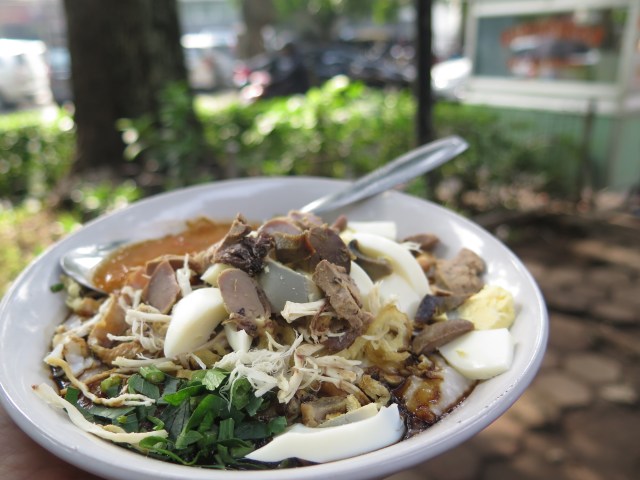





















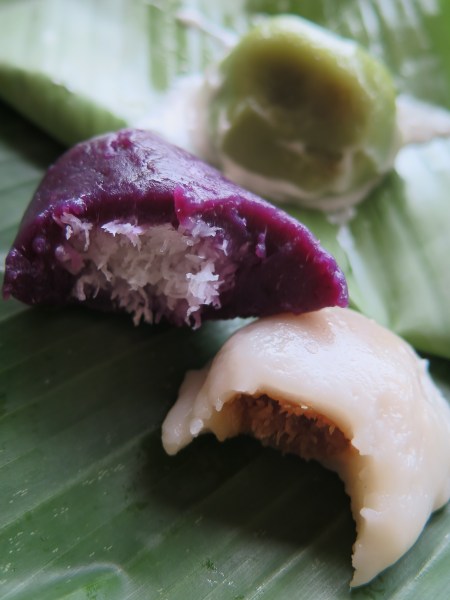





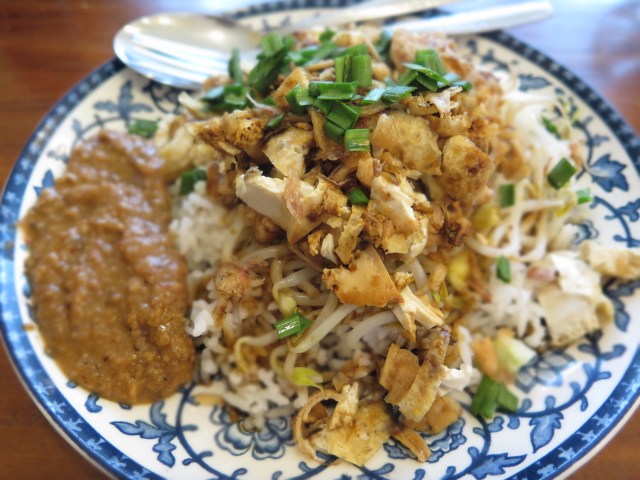


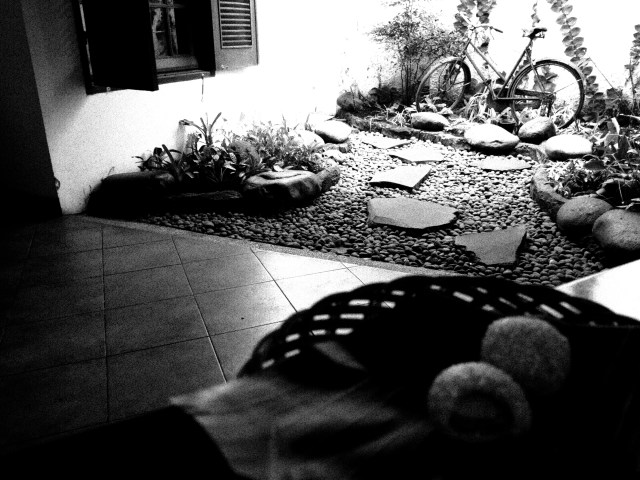


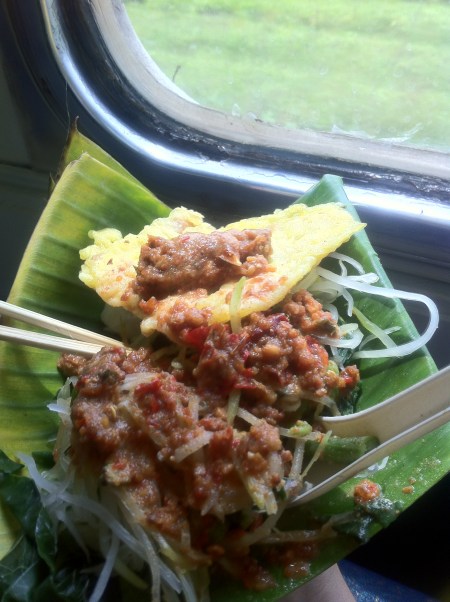




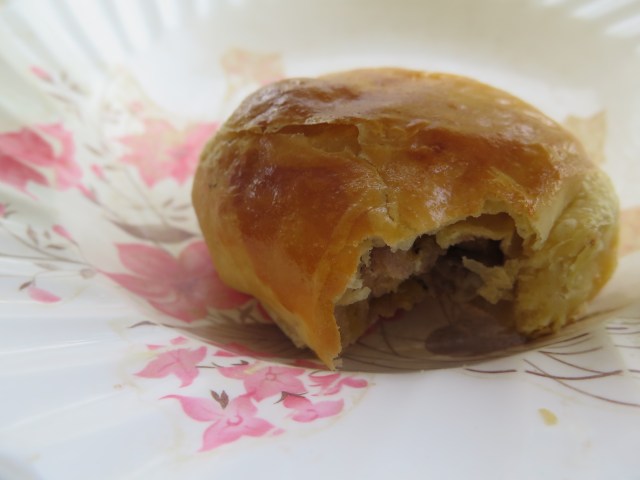


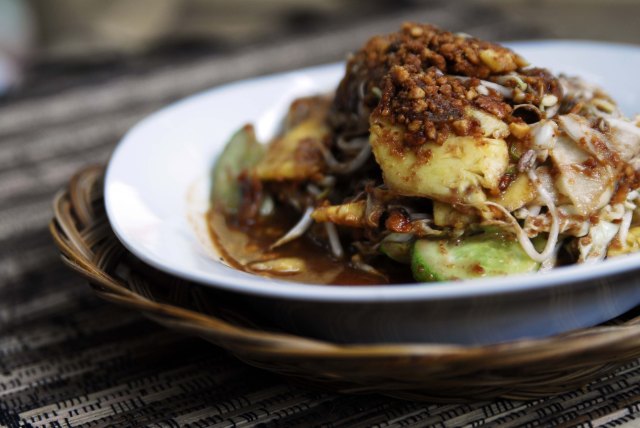

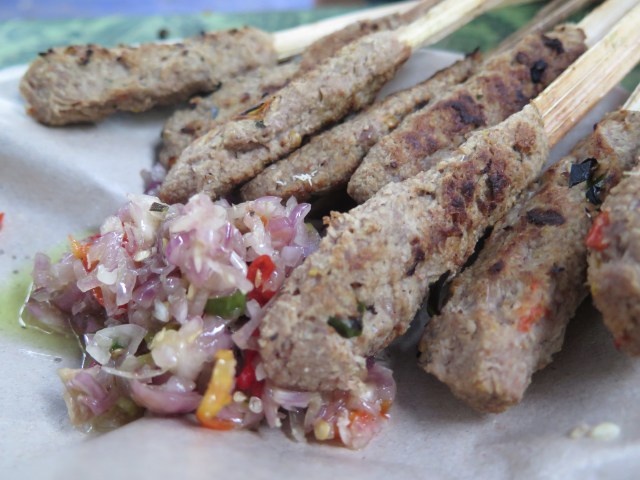










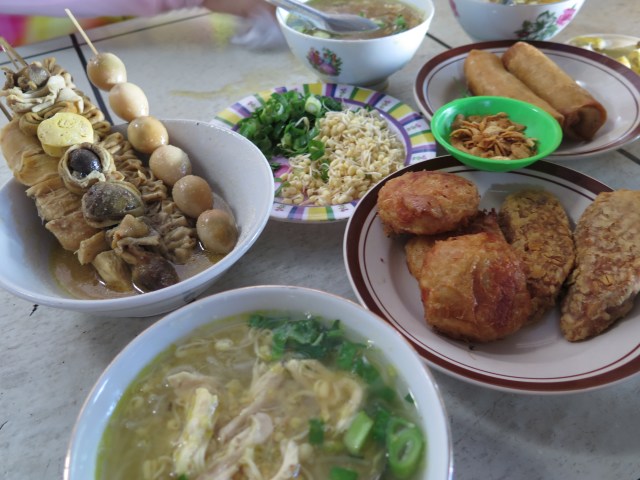









Wooowww…….Julia keren banget artikelnya !!!!! #fourthumbsup 🙂
cangkaleng not cangkelang 😉
Kereeeeen……Julz! Marvelous….. you’re really a bule with Indonesian taste.
Such a passion here Julia … for writing, recipes and rumbly tummies. Eat your heart out Jamie ….
Enjoyed this exploration across the archipelago- well done. http://www.culturekitchenfoodlab.wordpress.com
Thank you kindly Angie! Very much appreciate a comment from such an eminent Indonesian cuisine enthusiast!
[…] Almost A-Z of My Favourite Indonesian Cuisine (So Far) […]